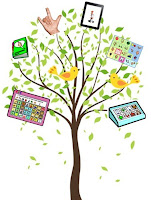 Augmentative Alternative Communication (AAC) includes all
forms of communication, besides oral speech, and is used to express an
individual’s thoughts, needs, wants or ideas. There are many different types of
AAC, ranging from unaided communication systems, such as gestures, body
language, and sign language, to aided communication systems, which require
tools such as voice output boards and picture symbols. As we learned in the video
overview, there is a spectrum of AAC devices that range from low tech to high tech,
which can be utilized depending upon the unique needs of each individual.
Augmentative Alternative Communication (AAC) includes all
forms of communication, besides oral speech, and is used to express an
individual’s thoughts, needs, wants or ideas. There are many different types of
AAC, ranging from unaided communication systems, such as gestures, body
language, and sign language, to aided communication systems, which require
tools such as voice output boards and picture symbols. As we learned in the video
overview, there is a spectrum of AAC devices that range from low tech to high tech,
which can be utilized depending upon the unique needs of each individual.
Things to consider:
1. Who are the members that should be involved in the AAC planning process?
If possible, it is important that all team members should be present when determining what AAC device should be used and how it should be implemented in the classroom and/or home environment. These team members should include, the student's parents, speech-language therapist, teacher, teaching assistant, occupational therapist, physical therapist, and anyone else that may be involved in this child's immediate environment. Although this is not always feasible for all team members to be present at every meeting, it is crucial that these professionals and parents maintain constant communication to ensure the device is being used effectively to support the child's needs. As noted in the overview, it is especially important that the teaching assistant be up to date on the usage of the AAC device because they usually spend as much time with the students as the teacher. In addition, the TA is usually with students during periods of the day where there are greater opportunities for socialization, such as lunch and recess.
The first step of incorporating an AAC device into a classroom would be to bring the entire team together to discuss the child's specific needs and decide how the device will be used to address those needs. It is important that each team member is on the same page about how the device will be used, including when and where. It is also crucial that all members are knowledgeable about using the device themselves and programming the device if necessary. Furthermore, if this device is being introduced to the child for the first time, an appropriate training procedure must be put into place. The environment will also have to be manipulated in order to effectively incorporate this form of AAC into the classroom. This includes identifying and prioritizing the communication activities that occur throughout the school day and depicting the appropriate message sets on any communication boards that are specific for the student. Many communication boards come with a predetermined board, but it then must be customized for each student.
Reflection:
The creation of the numerous AAC devices that are now available around the world is truly an amazing thing. AAC gives those with speech/language impairments a voice, and a way to communicate that was not available decades ago. I strongly support the use of such devices in the classroom for any student that can benefit from its use. However, obtaining an AAC device and placing it in a classroom is not where the process ends. Communication is a process, it is something that is ongoing and must be supported with technology as well as techniques that are used in the classroom. For instance, there are many different forms of AAC, as shown on the PRC, Zygo, and Dynavox websites. Not all devices will work for every student, thus a device must be paired with the child based on his or her abilities and disabilities. The student must then be trained on how to use the device as well as the teachers, parents, and any professionals that will be working with the child. As the student grows and progresses, it may necessary to switch to a more complex device such as the large digital boards available through Dynavox.







